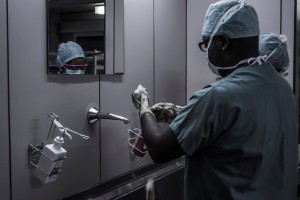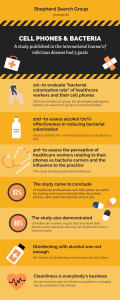If you were to survey the patients of a hospital and ask them, which healthcare professionals make a difference? The last to come to mind would be the infection control professionals.
Yet these medical professionals are essential to almost every quality metric in healthcare; safety, patient experience, and clinical excellence. Put it this way, if the medical equipment and infection control procedures are not up to standard, most departments will shut down.
Most of the time, the important work of these professionals goes unnoticed as they operate in “stealth ninja mode.” They work behind the scenes auditing and creating medical procedures, making recommendations for effective medical equipment, and educating medical teams.
The traditional focus of infection control professionals and departments has been to mitigate the spread of germs in hospitals. Infection control is following the trend towards the digital age of innovation.
As with other hospital departments, infection control professionals need to be aware of the most current innovations.
Here is an innovation that will immediately capture your imagination!
1. Virtual Reality and its transformational effect on Infection Control training
As always, we are a step ahead in presenting you with the latest innovation and technology keeping you current with the latest trends.
If you are an infection control professional, here is the tech, innovation, and current procedures you need to keep your eye on.
According to the WHO (World Healthcare Organization) US, patients spend 400,000 extra days in hospitals costing the industry an astounding $10 billion per year. Through effective infection control procedures, the chances of post-op infections are minimalized. Providing instruction in hygiene and effective control procedures within the OR is the key issues addressed in most training programs.
To overcome this issue, a group of Universities from Europe joined forces with the startup Simango, a company specializing in the creation of “simulation-based educational tools.”
When students first enter a hospital OR for training, many feel overwhelmed and sometimes this results in risky behavior. Virtual Reality training provides a safer and more tactile experience allowing for learning without fear. Virtual training offers students access to all the tools that are in a physical OR.
Project leader Caroline Landelle of the University of Grenoble Alpes says that Virtual Reality training enthuses her students, as they are eager to engage with the latest technology. Landelle also says it is uncommon to find infection control in medical curricula, yet it is very significant when it comes to patient safety. Landelle says there is no reason why medical schools cannot benefit from Virtual Reality training across the globe.
2. Have you ever heard of technology for washing your hands?
When was the last time you heard of using technology to enhance washing your hands? That is because washing your hands has not changed much in centuries. However, in the infection control world, washing hands is the basis for stopping the spread of infection.
You read it here first, there are big data and the Internet of Things (IoT) sensors that are being used to monitor and provide unbiased information, that believe it, or not, accurately measures handwashing performance! Other measurements such as human observation are prone to biases such as the Hawthorn Effect. You may be asking so what is the idea behind the Hawthorn Effect?
The Hawthorn Effect is when the care provider knows they are being watched when they are washing their hands. More times than not, they know they are being observed through a camera lens or by some other device. It makes sense that they are three times more likely to clean their hands well.
Most electronic hand hygiene devices can effectively be integrated with electronic medical record systems. There is a seamless exchange of data between both devices, “automatically syncing patient condition with hand hygiene protocols in the system.” Combining both data sets enables the identification of patients that present a higher risk for infection.
3. Disinfecting your mobile device with ReadyDock
When you enter through the doors of any hospital, you will notice that no one asks you to put your cell phone in a sealed bag. That is because physicians, nurses and other medical staff walk around freely with mobile devices. Warning! smartphones have high-touch surfaces that need to be disinfected regularly. It is no surprise that hospitals are implementing policies to prohibit employees from using mobiles while on duty.
ReadyDock is a firm that developed a chemical-free disinfection multi-bay docking station. Using this solution, healthcare professionals can simultaneously charge and disinfect their mobiles or tablets while at work. Healthcare workers can keep ReadyDock in a communal area allowing healthcare professionals access. The five-tray docking station uses germicidal light, which is “able to disinfect a mobile phone in under a minute.”
Like us, you are probably wondering why a technology firm such as ReadyDock designed such a device. The following research will demonstrate why hospitals need to use this innovation.
The study published in the International Journal of Infectious Diseases had three goals
(https://www.ijidonline.com/article/S1201-9712(18)33567-7/fulltext)
- The first was to evaluate the “bacterial colonization rate” of 45 cell phones belonging to healthcare workers. Twenty cell phones belonged to operating room medical professionals, and 25 cell phones belonged to medical professionals from other departments.
- The second was to assess if disinfection with alcohol (70%) is effective in reducing the bacterial colonization of cell phones.
- The third was to assess the perception of healthcare workers relating to their phones as bacteria carriers, and the influence this has on their clinical/surgical practice.
What the study demonstrated
- The 45 cell phones were swabbed front and back, then cleaned with 70% alcohol. Thirty-five of the 45 or 78% developed pathogenic bacteria (bacteria that can cause disease) and 6 cases were polymicrobial “denotes a disease state involving multiple species of microorganisms.” After 10 minutes the cell phones were swabbed again with the same technique resulting in 4 of the 45 or 9% with pathogenic bacteria.
- Alcohol disinfection minimized bacteria colonization by 69%.
- Polymicrobial infections
What the study found
92% of healthcare professionals saw their cell phones as useful for solving work issues.
92% said they clean their phone and over half of them say they do so once a day.
86% of healthcare workers report that they think their phone carries bacteria, but only 41% believe this has a clinical impact.
From this study, we can clearly see that cell phones of healthcare workers carry a high risk of bacteria, researchers said that this has a huge potential to cause nosocomial infections, infections that originate in a hospital and are resistant to antibiotics.
Disinfecting cell phones using alcohol was effective at minimizing the risk of infection. As the research concluded, this supports the need for hospitals to implement policies for healthcare workers to clean their phones with greater frequency.
(Data repurposed on the infographic is from the research paper titled “Mobile phones: a potential source of nosocomial infection” by L.Guzzi; M.G. Hinojosa; A.H. Pescio et al… published in the International Journal for Infectious Diseases https://www.ijidonline.com/article/S1201-9712(18)33567-7/fulltext)
The post Capturing Imagination with Cutting-Edge Technology appeared first on Merraine.



